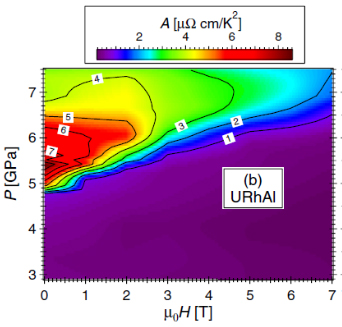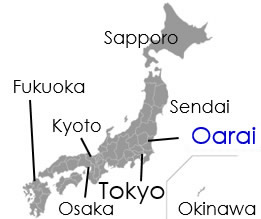(2015/03/09)

Resistivity measurements were performed for the itinerant Ising-type ferromagnet URhAl at temperatures down to 40 mK under high pressure up to 7.5 GPa, using single crystals. We found that the critical pressure of the Curie temperature exists at around Pc∼ 5.2 GPa. Near Pc, the A coefficient of the Fermi-liquid resistivity term below T∗ is largely enhanced with a maximum around 5.2–5.5 GPa. Above Pc, the exponent of the resistivity ρ(T) deviates from 2. At Pc, it is close to n=5/3, which is expected by the theory of three-dimensional ferromagnetic spin fluctuations for a second-order quantum-critical point (QCP). However, TC(P) disappears as a first-order phase transition, and the critical behavior of resistivity in URhAl cannot be explained by the theory of a second-order QCP. The first-order nature of the phase transition is weak, and the electron system in URhAl is still dominated by the spin fluctuation at low temperature. With increasing pressure, the non-Fermi-liquid behavior is observed in higher fields. Magnetic field studies point out a ferromagnetic wing structure with a tricritical point (TCP) at ∼4.8–4.9 GPa in URhAl. One open possibility is that the switch from the ferromagnetic to the paramagnetic states does not occur simply but an intermediate state arises below the TCP as suggested theoretically recently. Quite generally, if a drastic Fermi-surface change occurs through Pc, the nature of the interaction itself may change and lead to the observed unconventional behavior.た。
PHYSICAL REVIEW B Vol. 91, 125115 (2015).
http://DOI: 10.1103/PhysRevB.91.125115


